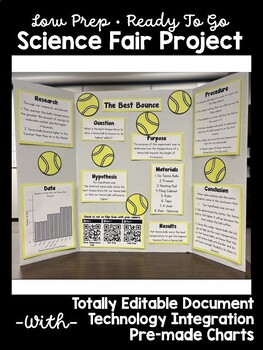Science Fair Project - The Effects of Temperature on Tennis Balls
Kaitlin Callies
96 Followers
Grade Levels
1st - 5th
Subjects
Resource Type
Standards
NGSSK-2-ETS1-3
NGSSK-2-ETS1-1
NGSS3-5-ETS1-3
NGSS2-PS1-2
NGSSMS-ETS1-1
Formats Included
- PPTX
Pages
13 pages
Kaitlin Callies
96 Followers
Description
***$1.00 for the next 48 hours if you leave a review!***
Science Fair happening at a busy time for you?
Here's your solution!
This file contains a quick print, ready to go science fair presentation that is 100% EDITABLE! All you need to complete is the technology component of having your students record the Flip (formerly FlipGrid) video while your class is testing out the trials!
The slides that are included and filled out are:
-Purpose
-Question
-Hypothesis
-Research
-Title
-Flip QR code space
-Materials
-Procedure
-Data
-Results
-Conclusion
-Tennis Ball Printable Decorations
-An example of the completed board is on slide 1!
This project has taken FIRST PLACE in a school-wide science fair. Easily adaptable for a whole class or just one student.
Total Pages
13 pages
Answer Key
N/A
Teaching Duration
N/A
Report this resource to TPT
Reported resources will be reviewed by our team. Report this resource to let us know if this resource violates TPT’s content guidelines.
Standards
to see state-specific standards (only available in the US).
NGSSK-2-ETS1-3
Analyze data from tests of two objects designed to solve the same problem to compare the strengths and weaknesses of how each performs.
NGSSK-2-ETS1-1
Ask questions, make observations, and gather information about a situation people want to change to define a simple problem that can be solved through the development of a new or improved object or tool.
NGSS3-5-ETS1-3
Plan and carry out fair tests in which variables are controlled and failure points are considered to identify aspects of a model or prototype that can be improved.
NGSS2-PS1-2
Analyze data obtained from testing different materials to determine which materials have the properties that are best suited for an intended purpose. Examples of properties could include, strength, flexibility, hardness, texture, and absorbency. Assessment of quantitative measurements is limited to length.
NGSSMS-ETS1-1
Define the criteria and constraints of a design problem with sufficient precision to ensure a successful solution, taking into account relevant scientific principles and potential impacts on people and the natural environment that may limit possible solutions.



